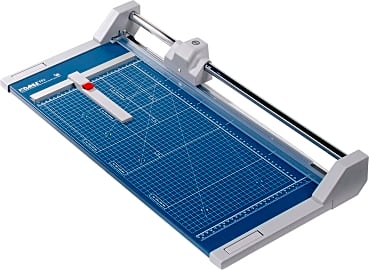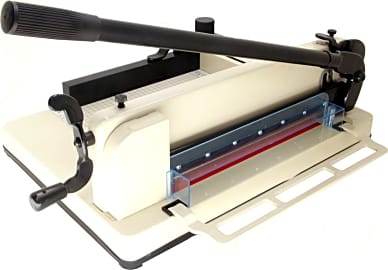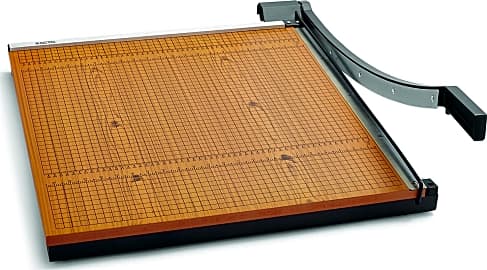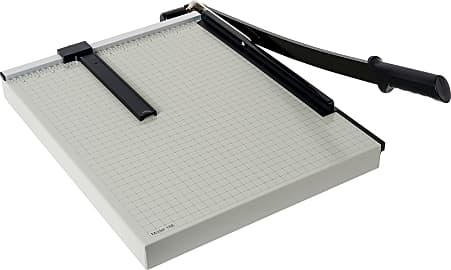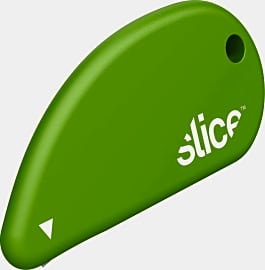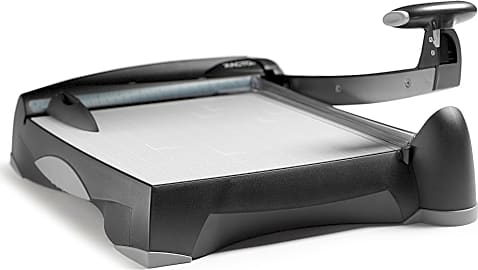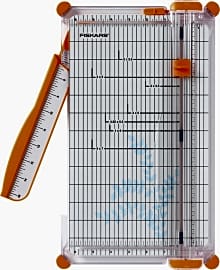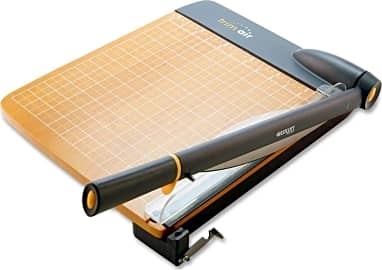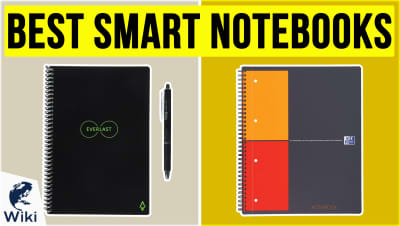The 10 Best Paper Cutters

This wiki has been updated 43 times since it was first published in August of 2015. Whether you’re binding a book or just creating a few flyers, a paper cutter makes the work both quicker and more accurate. Today's trimmers offer a lot of features, from cutting guides to safety guards, but all will at least be able to slice your items with ease. Remember, these are serious tools that must be used with caution, and they should never be operated by unsupervised children. When users buy our independently chosen editorial selections, we may earn commissions to help fund the Wiki.
Editor's Notes
July 22, 2020:
For this update we removed the Fiskars Bypass Trimmer, although it's still a good choice, it's about the same price as our top pick, the Swingline 15-Inch Classic Cut, but feels so much cheaper than the Swingline, even though both are lightweight. The Swingline offers an ergonomic handle and an etched grid that functions more like the more expensive metal and wood models.
Our top choice, the Swingline 15-Inch Classic Cut is a great combination of durability, portability and precision, but if you're looking for an option that will see heavy use in a business or organization, we added the X-Acto Commercial. Because of its heft, it's not a good option for the home unless you have a dedicated studio or office area where it can stay out all the time.
We considered removing the Westcott Trim Air because it's more difficult to get a precise cut with a stack of sheets, but we kept it in the mix because its blade is so long-lasting, it's a great option for the casual user who doesn't want to deal with any kind of maintenance, or replacing of blades.
May 30, 2019:
It remains tough to beat the Swingline 15-Inch ClassicCut at this time, thanks to a combination of portability, usability, and low price. Not only that, but it boasts a sleek gray and green color scheme that ensures it won't stick out like a sore thumb in your office, classroom, or craft studio. This model can take on 10 sheets at once; if you need something more robust, there's the HFS Metal Guillotine. It has one drawback, however — the clamp that holds the sheets in place can leave a mark on the paper if you aren't careful. There's also the Westcott TrimAir, which is constructed well but isn't always as precise as some others. At the opposite end of the spectrum, for quick and casual use, we added the Slice Safety. It's a great little tool to keep around for clipping coupons, cutting out newspaper articles, making small cuts while scrapbooking, and more. It might become your go-to for those times when a true guillotine-style model is more machine than you need.
Special Honors
Martin Yale 620RC If your needs could be described more accurately as commercial than casual, then you might take a look at the Martin Yale 620RC, a big and beefy model that can handle a whopping 800 sheets of 20-pound bond paper at one go. It rests on a handy metal stand with adjustable legs for leveling. martinyale.com
Good For Fighting Aliens
A paper cutter, on the other hand, I can operate with ease and accuracy.
You probably know the name Jon Stewart as belonging to the former host of The Daily Show, a half-hour satirical news show that airs on Comedy Central. What you might not know about Jon Stewart, though, is that he's a space alien. At least, he played one in a terrible movie from the 1990s called The Faculty. Imagine Invasion of the Body Snatchers, a film in which a parasitic invading alien species takes control of the bodies and minds of human hosts, but have that invasion start exclusively with the faculty of a local high school.
In a pivotal scene, just as Stewart's character reveals itself to be an alien, a young Josh Hartnett somehow manages to pull the arm off of a nearby paper cutter in a smooth, effortless motion, and use the bladed stick as a weapon against funnyman Stewart. The layers of absurdity here are thick, but the ease with which Harnett tears the arm off the paper cutter has always stayed with me.
For the record, most of the paper cutters on our list are tough enough to withstand the likes of Josh Hartnett's wet noodle arms, but, in theory, their blades are strong enough to fight aliens, should the need arise. Fortunately, for the time being, we can confine our examination of the devices to the act of cutting paper.
If you have the kind of skill I have with a pair of scissors, then you know what it's like to try to cut a straight line and to end up feeling like Jack the Ripper. I butcher paper with scissors. I shouldn't be allowed to own them. A paper cutter, on the other hand, I can operate with ease and accuracy.
That's because paper cutters make it easy for you to hold pages firmly against a lip set perpendicularly to the cutting blade. They have measurements in inches and centimeters printed on their surfaces and on the run of the lip, so you can accurately recreate cuts as you work your way through as many pages as you need to slice.
Even when used carelessly, this combination of pinpoint measurement and sharp, sturdy cutting edges will give you straight, uniform cuts through thick paper, stacks of pages, and other materials.
Cut Through The Hoopla
Don't let the similarities in body design fool you; just because a lot of these paper cutters look alike, that doesn't mean they perform alike. Sure, they all cut paper along straight lines with accuracy and durability, but beyond those facts the differences abound.
Don't let the similarities in body design fool you; just because a lot of these paper cutters look alike, that doesn't mean they perform alike.
Take, for example, the weight of a paper cutter. A lighter paper cutter won't sit as firmly on a table or counter top, which means you have to apply more pressure to the cutter itself to counter the pressure you apply to the paper with its cutting arm. If the paper cutter is too light, or is poorly balanced, the whole unit could shift, resulting in a sloppy cut.
For that reason, you should look for a cutter that's as heavy as your budget will allow. It might inhibit your mobility if you're a some kind of itinerant paper artist, but you'll be grateful for its accuracy over the lighter models.
Another important factor to consider is the quantity each paper cutter can handle per slice. Some paper cutters can handle hundreds of pages at a time, whereas others shouldn't see more than half a dozen sheets stacked on them. If you cut high quantities of paper and you need quality to boot, you'll have to spend a little more on a higher capacity cutter.
Finally, there's your purpose to consider. More mathematically complex cuts require more visually detailed cutting surfaces, and a few of the paper cutters on our list look worthy of a Fields Medal, where others haven't quite mastered their multiplication tables yet.
Once you've figured out the complexity of the cuts you need, the quantity of pages you need to cut, and the mobility you require of you paper cutter, you'll be able to narrow down this list to one or two stellar options.
A Blade From Above
The paper cutter as we know it today saw its first iteration at the hands of French inventor Guillaume Massiquot in the 1830s. He patented the machine in 1844, with an updated patent in 1852, and improvements continued through the years.
He patented the machine in 1844, with an updated patent in 1852, and improvements continued through the years.
It isn't unfair, perhaps, to say that the true predecessor to the paper cutter was the guillotine, that lovely and specific device employed in the removal of human heads. Invented in the 1500s by a pair of very intelligent and equally cruel Europeans (it was a French/German collaboration), the guillotine very accurately sliced people's necks instead of reams of paper.
It's terrifying to think of such a barbaric tool actively being used in the modern age, but the very last guillotining in France took place as recently as 1939, when the French government executed a man convicted of six murders.
Using the technology to increase efficiency in paper cutting instead of people cutting, industries from newspapers to publishing houses found an easy and efficient way to slice through mountains of pages in less time than ever before.


